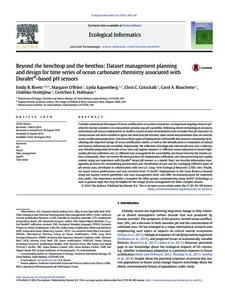| dc.contributor.author | Rivest, Emily B. | |
| dc.contributor.author | O'Brien, Margaret | |
| dc.contributor.author | Kapsenberg, Lydia | |
| dc.contributor.author | Gotschalk, Chris C. | |
| dc.contributor.author | Blanchette, Carol A. | |
| dc.contributor.author | Hoshijima, Umihiko | |
| dc.contributor.author | Hofmann, Gretchen E. | |
| dc.date.accessioned | 2018-07-07T21:43:34Z | |
| dc.date.available | 2018-07-07T21:43:34Z | |
| dc.date.issued | 2016 | |
| dc.identifier.citation | Rivest, E.B.; O'Brien, M.; Kapsenberg, L.; et al (2016) Beyond the benchtop and the benthos: Dataset management planning and design for time series of ocean carbonate chemistry associated with
Durafet®-based pH sensors. Ecological Informatics, 36, pp.209-220. DOI: http://dx.doi.org/10.1016/j.ecoinf.2016.08.005. | en_US |
| dc.identifier.uri | http://hdl.handle.net/11329/468 | |
| dc.identifier.uri | http://dx.doi.org/10.25607/OBP-52 | |
| dc.description.abstract | To better understand the impact of ocean acidification on marine ecosystems, an important ongoing research priority for marine scientists is to characterize present-day pH variability. Following recent technological advances, autonomous pH sensor deployments in shallow coastal marine environments have revealed that pH dynamics in coastal oceans are more variable in space and time than the discrete, open-ocean measurements that are used for ocean acidification projections. Data from these types of deployments will benefit the research community by facilitating the improved design of ocean acidification studies as well as the identification or evaluation of natural and human-influenced pH variability. Importantly, the collection of ecologically relevant pH data and a cohesive, user-friendly integration of results across sites and regions requires (1) effective sensor operation to ensure high-quality pH data collection and (2) efficient data management for accessibility and broad reuse by the marine science community. Here, we review the best practices for deployment, calibration, and data processing and quality control, using our experience with Durafet®-based pH sensors as a model. Next, we describe information management practices for streamlining preservation and distribution of data and for cataloging different types of pH sensor data, developed in collaboration with two U.S. Long Term Ecological Research (LTER) sites. Finally, we assess sensor performance and data recovery from 73 SeaFET deployments in the Santa Barbara Channel using our quality control guidelines and data management tools, and offer recommendations for improved data yields. Our experience provides a template for other groups contemplating using SeaFET technology as well as general steps that may be helpful for the design of data management for other complex sensors. | en_US |
| dc.language.iso | en | en_US |
| dc.rights | Attribution-NonCommercial-NoDerivs 3.0 IGO | * |
| dc.rights.uri | http://creativecommons.org/licenses/by-nc-nd/3.0/igo/ | * |
| dc.subject.other | Long Term Ecological Research (LTER) | en_US |
| dc.subject.other | Ocean acidification | en_US |
| dc.subject.other | SeaFET | en_US |
| dc.subject.other | Time series | en_US |
| dc.title | Beyond the benchtop and the benthos: Dataset management planning and design for time series of ocean carbonate chemistry associated with Durafet ® -based pH sensors. | en_US |
| dc.type | Journal Contribution | en_US |
| dc.description.refereed | Refereed | en_US |
| dc.format.pagerange | pp.209-220 | en_US |
| dc.identifier.doi | https://doi.org/10.1016/j.ecoinf.2016.08.005 | |
| dc.subject.instrumentType | Instrument Type Vocabulary::pH sensors | en_US |
| dc.subject.dmProcesses | Data Management Practices::Data acquisition | en_US |
| dc.subject.dmProcesses | Data Management Practices::Data quality management | en_US |
| dc.bibliographicCitation.title | Ecological Informatics | en_US |
| dc.bibliographicCitation.volume | 36 | en_US |
| dc.description.bptype | Guide | en_US |
 Repository of community practices in Ocean Research, Applications and Data/Information Management
Repository of community practices in Ocean Research, Applications and Data/Information Management

